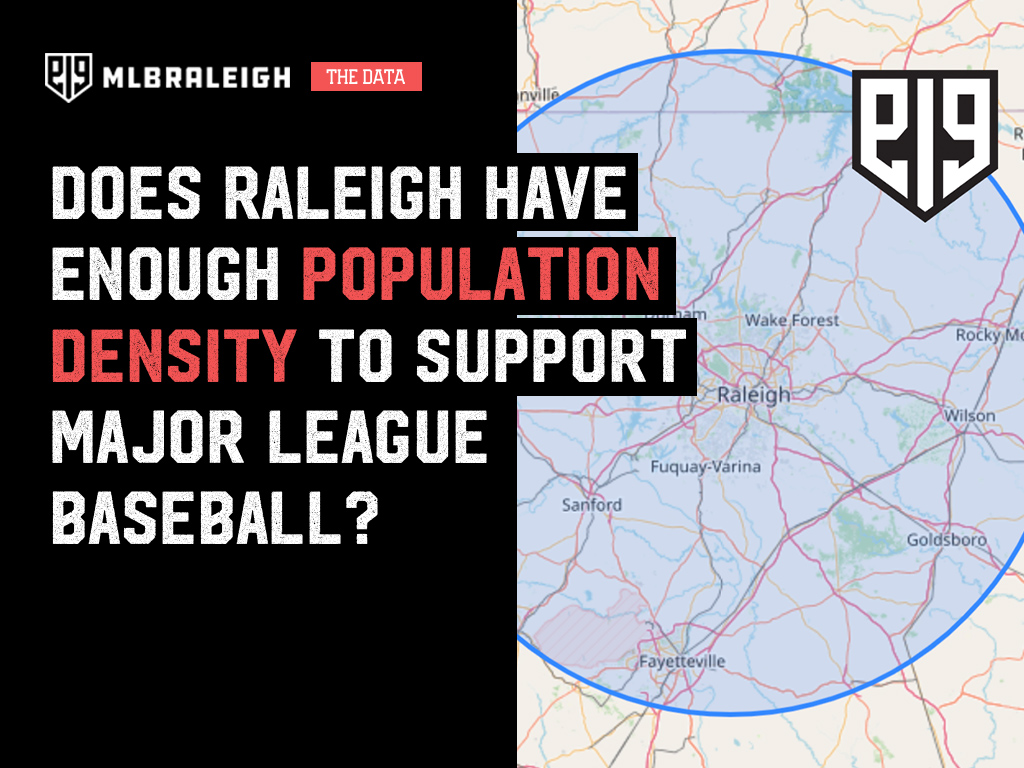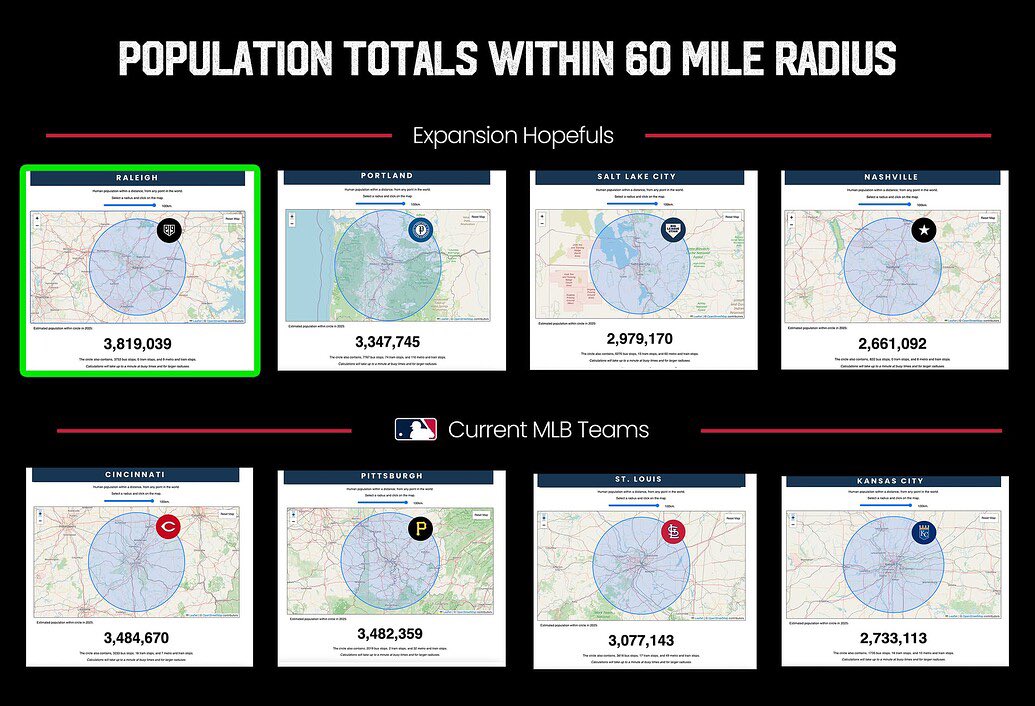
Does Raleigh have enough population density to support Major League Baseball?
For those who haven’t been paying attention to this movement and those who haven’t dug deep enough into the data, “Does Raleigh have enough population density to support Major League Baseball?” is likely the first question you have when entertaining the idea of Major League Baseball in Raleigh.
The reason population density matters is because, like any sport, you need to fill the seats on a nightly basis to make the math work on supporting a professional franchise. However, baseball is unique in that each team plays 162 games per season, 81 of which are at their home stadium.
So how do you measure this?
Well, the laziest way to measure this is by simply Googling “Raleigh population” and then taking that number and putting it up against existing cities that have successful MLB franchises. The problem with this is that measuring the population of the city isn’t going to give you good enough data. The number you want is, how many people live within driving distance of the stadium, and that number is going to include surrounding towns and cities.
But there is a way to measure that. It’s called MSA (Metro Statistical Area). So you’d think it’d be as simple as looking MSA population of existing MLB teams and measuring that against Raleigh’s MSA. And that’s what most people did prior to our organization’s existence. It’s why Raleigh was never in the conversation for Major League Baseball expansion and why the media never really took the region seriously as a viable contender for a franchise. Raleigh’s MSA is too small to support an MLB team, but then how do you explain the sold out stadiums for college basketball, college football, or the 67-game sell-out streak that the Carolina Hurricanes have going on.
When you dig into this, it’s simple.
Prior to the early 2000’s our MSA was known as the Triangle MSA and it combined both the current Raleigh MSA and the Durham MSA. Together they make up almost 5,000 square miles, including Cary, Apex and Morrisville (all within a 20 minute drive of downtown Raleigh). But in the early 2000’s the MSA was broken up. This was because what defines an MSA is commuter volume in and out.
Unlike most metros where the surrounding suburbians all funnel into the city for work, our region is unique. We have 3 major population points (Raleigh, Durham and Chapel Hill) on a single commuter belt, with most of the commuter heading to Research Triangle Park, a corporate park located directly in the middle of these 3 hubs.
This change created a situation where you now had the census reporting the Triangle area as two smaller cities. This dropped the region off of many lists and rankings that had them approaching major metro status just years earlier. To this day, the census discrepancy continues to exist.
So the first thing you could do is simply recombine the Raleigh and Durham Metro and put it up against existing traditional metros that currently have MLB teams. When you do that, you see that our Triangle MSA is larger in population than both Cleveland and Milwaukee (both of whom have successful MLB teams) and approaching Kansas City, Cincinnati, and Pittsburgh.
That is a decent way to measure, but still doesn’t give you a real apples-to-apples comparison of population density within driving distance of the stadium.
The reason it’s not perfect is because MSAs aren’t defined by square miles. They are defined by commuter data.
For instance, here are the crazy discrepancies you run into when you are trying to compare population density based on MSA.
- Raleigh/Durham (Triangle) Metro covers 4,408 square miles.
- Kansas City Metro covers 7,256 square miles.
- Pittsburgh Metro covers 5,282 square miles.
- St. Louis Metro covers 7,863 square miles.
So while MSA might be a decent way to measure population density in a region, as it is the most accessible (since it’s reported in the census), it doesn’t answer the question of “How many people live within driving distance of a potential stadium?”
So to get this number right, we looked for a more exact way to measure.
We used a tool, that could scope a custom area, and pull the census data, directly from a desired spot. For each region that has a current MLB team, we set that spot to their existing stadium. For the expansion contending cities, we looked at the most recent proposed location for a stadium. We set the tool to measure a 60 mile radius (approximately a 1-hour drive) Here is what we found…

Raleigh’s population density within that 60-mile radius was not only larger than every single MLB expansion contender, it was also larger than some areas that boast extremely successful MLB teams such as Cincinnati, St. Louis, and Pittsburgh. Also, not pictured was Milwaukee (3,580,570) who ranks #1 in per capita attendance in MLB.
So if the question is “Does Raleigh have enough population density to support Major League Baseball?”, the answer is: If Cincinnati, Pittsburgh, St. Louis, Kansas City, and Milwaukee have the population volume to fill their stadiums, then so does Raleigh.
And with Nashville, Salt Lake City, and Portland being the current competing markets for MLB expansion, why wouldn’t you choose the Raleigh? We are not only growing faster than every single MLB market, but also boast more people within driving distance of a potential stadium than any other current option on the table.
The thoery that this market is too small or couldn’t fill an MLB stadium 81 nights per year is invalid. It’s not based on real statistics and that debate should be considered ‘over’.